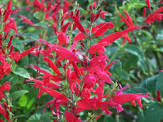Sage Osteopenia Osteoporosis - Natural treatment
Sage Osteopenia Osteoporosis - Your kitchen can help you grow stronger bones. This is not a new idea but many people, even health care workers, do not know about the Sage Osteopenia Osteoporosis connection.
In April of 2003 the journal Bone published a study by Scientists from Switzerland (Bone Biology Group, Department of Clinical Research, University of Bern) found that the dried leaves of the herb strongly inhibit bone resorption.
Now, if you recall 'bone resorption' is the name given to the process by which your Osteoclasts removed old bone. Inhibiting
bone resorption is the process behind a number of well known Osteopenia
and Osteoporosis drugs, among them the bisphosphonates such as Actonel, Boniva and Fosamax.
Now I am not suggesting that you drop your prescription drugs and start taking sage as a substitute. But you might want to include this herb in your meal preparation or add some to your tea.
Herbs: Sage Osteopenia Osteoporosis
This herb is a silvery-green plant. There are a number of
different varieties. The most common form is found in the lands around
the Mediterranean. But the plant is quite easy to grow and is now found
throughout much of North America and many parts of Europe.
Most people recognize sage by the memorable fragrance of its leaves or by its purple flowers when it is in bloom. Some people tie small bundles in closets or they place leaves in lightly woven cloth to act as sachets in drawers with scarves or underwear. But if you are trying to combat Osteopenia or Osteoporosis, you want to eat the herb - not just hang is as a sachet.
There are a number of different types. Mexican sage is not edible. It is usually grown for its bright red flowers that bloom late in the Fall. Edible forms are 'common sage' and pineapple sage. You can sprinkle these on salads or enjoy a tea of the leaves.

The fresh leaves of pineapple form (Shown here) have a distinctly pineapple taste. It goes well with chicken, pork dishes, cheeses or even fruit salad.
When using this herb, it is good to remember to use it sparingly. You will know if you exceed the right dose by a rather pungent odor coupled with musty taste to your food!.
Of course, sage tea is a different story. If you are a tea drinker, you might try sprinkling a few leaves in your next cup.
The herb has long been used in traditional healing practices. But we know that if you are pregnant you should NOT USE IT. Also it should not be used by those with high blood pressure or epilepsy.
If you want to read the study by the Swiss, your public library may be able to get a copy of Bone. 2003 Apr;32(4):372-80 from your library. If you can not get a copy there and you have access to a college or university library, they should be able to obtain a copy through Interlibrary loan
There is also another web site about sage and bones
Oh, and yes, you should let your health care provider know of any and all things you are doing in regard to your Osteopenia or Osteoporosis.
